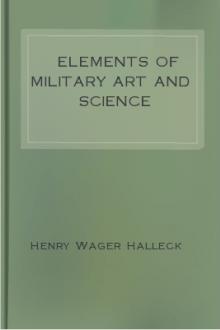Elements of Military Art and Science by Henry Wager Halleck (books you have to read txt) 📕

- Author: Henry Wager Halleck
- Performer: -
Book online «Elements of Military Art and Science by Henry Wager Halleck (books you have to read txt) 📕». Author Henry Wager Halleck
The personnel of artillery in modern army organization is divided into four classes: the staff, guards, artificers, and troops.
I. The Staff, or Ordnance, as it is called in our service, is charged with the construction of all the materials of artillery, and the collection of powder and military stores. As the lives of persons using these materials, and, in a considerable degree, the success of war, depend upon the nature and quality of the stores thus manufactured and collected, it is obvious that the members of this branch of the artillery service should possess high and peculiar qualifications. In the French army the artillery staff is composed of two hundred and eighty-three officers of different grades: also twenty-four officers of the general staff are attached to this service. In our army the ordnance is composed of twenty-eight officers of different grades.
II. Artillery-guards.—These in our service are divided into two classes: 1st. Military Store-keepers. 2d. Ordnance Sergeants. Both are alike charged with the care and preservation of the artillery property and stores at the several garrisons, arsenals, and magazines. In our army we have fifty-eight of these guards, viz: fifteen commissioned military store-keepers, and forty-three ordnance sergeants. We seldom have more than this number of permanent posts; each one can therefore be supplied with an artillery guard for the care of the artillery stores. In the French service there are three hundred and fifteen of these artillery guards; they are divided into three classes.
III. Artificers.—This class of men are employed in the construction and repairs of military materials. In most of our arsenals and armories it is thought to be best to employ unenlisted workmen, by the piece or contract. Nevertheless a limited number of enlisted men of this description are found to be both useful and necessary. We have three hundred and thirty of these in our army, viz: two hundred and fifty enlisted "ordnance men," and eighty "artificers" attached to the regiments. In the French army they have for the service of the arsenals and establishments, one hundred and forty-nine "ouvriers," and twelve "artificers;" there are also three hundred and sixty "ouvriers" and seventeen "armuriers" attached to the corps of artillery, making in all five hundred and thirty-eight.
IV. Artillery Troops.—Artillery, as an arm of service, is divided in the same manner as its materiel; the field-artillery being intended for field service, and the garrison or siege-artillery, for the attack and defence of places. The troops of the artillery corps of a modern army usually do duty either in the field, or in sieges, or garrison, as occasion may require. When employed in the service of a campaign, artillery is usually divided into two classes: 1st. Foot Artillery; and 2d. Horse Artillery.
In the early history of artillery, as has already been shown, but few pieces were ever brought upon the battle-field. Charles VIII. crossed the Alps with a pretty large train; but a part of these were hand-guns, and but very few of the larger pieces were ever brought into battle; indeed, it was then thought that this arm would be of little use except in sieges. At the battle of Gravelines the army of Philip II. had only seventeen pieces of artillery; and at the battle of Ivry the French had only four pieces of cannon, and two culverins: the army of the League had also only four pieces. At the battle of Moncontour the opposing armies had but eight pieces each.
Gustavus Adolphus of Sweden not only improved the character of artillery, but also gave to it great development as an arm of service. At the battle of Bréetenfield he had one hundred pieces of artillery, great and small, and at the camp of Nuremberg he numbered about three hundred. This king also made a more skilful use of his cannon by uniting them more in mass than had been done by his predecessors; his system was nevertheless very imperfect. In the disposition of this arm on the field of battle, a vast improvement was made by Condé, Turenne, and Prince Eugene of Savoy. Frederick the Great also made great use of this arm, and was the first to introduce horse artillery. This mode of using field-pieces has peculiar properties which in many circumstances render it an invaluable arm. The promptness and rapidity of its movements enable it to act with other troops without embarrassing them. The French soon introduced into their army the improvements made by the king of Prussia, and in 1763 the celebrated Gribeauval appeared. He improved the form of the cannon and greatly diminished the weight of field artillery, giving it an organization which has been but slightly changed since his time.
The successive improvements in artillery have for a long time constituted a prominent feature in war. The power of this arm to throw projectiles to a great distance, and to overturn and destroy opposing obstacles, renders it a necessary arm on the battle-field, and a strong barrier and safeguard of states. It is an essential element in all army organization.
In our army we have four regiments of artillery, forming the basis of forty batteries. In the French service there are fourteen regiments, forming the basis of two hundred and six field batteries.
The term battery, when applied to artillery as an arm of service, refers to a permanent organization of a certain number of cannon, with the men and other accessaries required to serve them. This is the unit of force in this arm. The regimental organization is a mere nominal arrangement, for in actual service artillery acts by batteries, and never by regiments. Its strength is therefore invariably estimated by the number of its batteries.
A battery is ordinarily composed of six pieces, two of them being howitzers. The lighter batteries would, in our service, be formed of six-pounder guns and twelve-pounder howitzers; and the heavier of twelve-pounder guns and twenty-four-pounder howitzers. These heavy batteries would usually form the reserve. Each piece being attended by its caisson, this formation would give twelve carriages to each battery, six for the guns and six for the caissons. The extra caissons form a part of the reserve, and move with the train. In some foreign services a battery is composed of eight pieces with their caissons.
This arm admits of three formations—in column, in battle, and in battery. In column it ordinarily moves by sections of two pieces, each piece being followed or preceded by its caisson. Columns of half-batteries are sometimes formed, and also columns of single pieces; but the latter ought never to be employed except in cases of necessity in passing a narrow defile, and at a distance from the enemy.
In order of battle, the pieces are drawn up in line, their caissons forming a second line, at the distance of a few paces.
When in order of battery, the pieces are formed in the same way as for battle, except that the guns are directed towards the enemy and prepared for firing.
The movements and manœuvres of foot artillery correspond with those of infantry, and of mounted artillery with those of cavalry, a battery being regarded as a battalion or squadron, of which the pieces form the platoons. Mounted batteries can seldom move with greater rapidity than the trot, except in cases of emergency, and even then the gallop can be kept up only for a very short time; but this is of no great importance, as the batteries never accompany cavalry in the charge.
The French and German writers discuss artillery as employed in battle, under two distinct heads—1st, as an arm of preparation, and 2d, as an arm of succor.
I. As an arm of preparation it serves, 1st, to protect the deploying of the other troops; 2d, to disorganize the enemy's masses, and to facilitate the action of infantry and cavalry, by weakening the intended points of attack; 3d, to force an enemy to evacuate a position by overthrowing obstacles with which he has covered himself; 4th, to keep up the action till the other troops can be prepared to strike the decisive blow.
The force of this arm depends upon the rapidity and accuracy of its fire; rash valor is therefore far less desirable in artillery than skill, patience, and cool courage. Artillery always acts at a distance, and in mass; single pieces are seldom employed, except to cover reconnoitring parties, or to sustain the light infantry in a skirmish. Mounted batteries sometimes approach within two or three hundred yards of the enemy's infantry; but this is only done with a strong support of other troops, and to prepare the way for a charge of cavalry. The batteries do not accompany the charge, but they should always follow up and complete the success; mounted batteries are particularly useful in pursuit. If Murat, in 1812, had accompanied his attacks upon Neveroffskoi's retreating columns of sixty thousand infantry by two or three batteries of mounted artillery, the whole column must have been captured or destroyed.
Artillery, on the field of battle, is very liable to allow its fire to be drawn, and its projectiles wasted, while the enemy is at too great a distance to be reached. It is a very common thing in a battle, to employ two or three pieces of heavy calibre at the beginning of the fight, in order to provoke the opposing batteries to open their fire before the proper time. The waste of material is not the only loss attending this error; the troops are fatigued and disheartened, while the courage and confidence of their opponents are always revived by a weak and inaccurate fire. To avoid such an error the commanding officer of a battery of artillery should be perfectly familiar with the effective ranges of his pieces, and accustomed to form a correct estimate of distances. For this purpose the eye should be frequently practised in time of peace in estimating the ranges for different calibres.
The effective range of a 12-pounder field-piece is about 1000 yds. The effective range of a 6-pounder field piece 800 The effective range of a 24-pounder howitzer 600 yds. The effective range of a 12-pounder howitzer 500 yds. The effective range of grape and case shot is from 500 to 600 yds.Even at these distances the aim is usually so inaccurate that a large portion of the projectiles are lost. In the attack on Spires, a whole column of artillery expended its fire while at a distance of 900 yards from the enemy, who, of course, received little or no injury. In firing from fortifications, the aim is far more accurate, and the artillery may therefore be employed to advantage as soon as the enemy comes within the longest range.
II. As an arm of succor, the artillery serves, 1st, to give impulsive force to the attacking columns; 2d, to assist in arresting, or at least in retarding, the offensive movements of an enemy; 3d, to protect the avenues of approach, and to defend obstacles that cover a position; and, 4th, to cover a retrograde movement.
Mounted artillery is, like cavalry, much the most effective in attack; but batteries of foot are better calculated for defence. The cannoniers are so armed as to be capable of defending their pieces to the last extremity; they therefore cannot be easily captured by opposing columns of infantry. "As to pretending to rush upon the guns," says Napoleon, "and carry them by the bayonet, or to pick off the gunners by musketry, these are chimerical ideas. Such things do sometimes happen; but have we not examples of still more extraordinary captures by a coup de main? As a general





Comments (0)